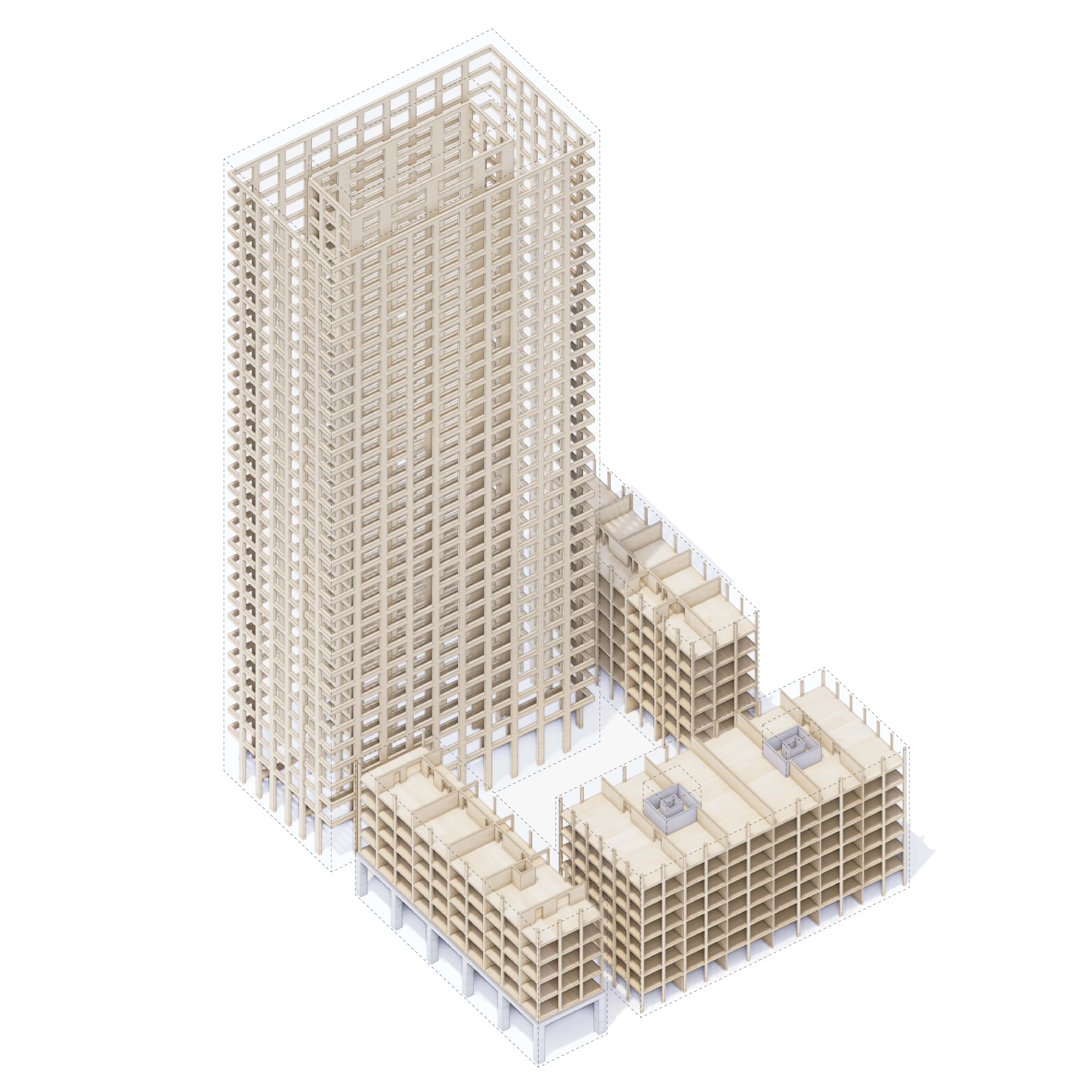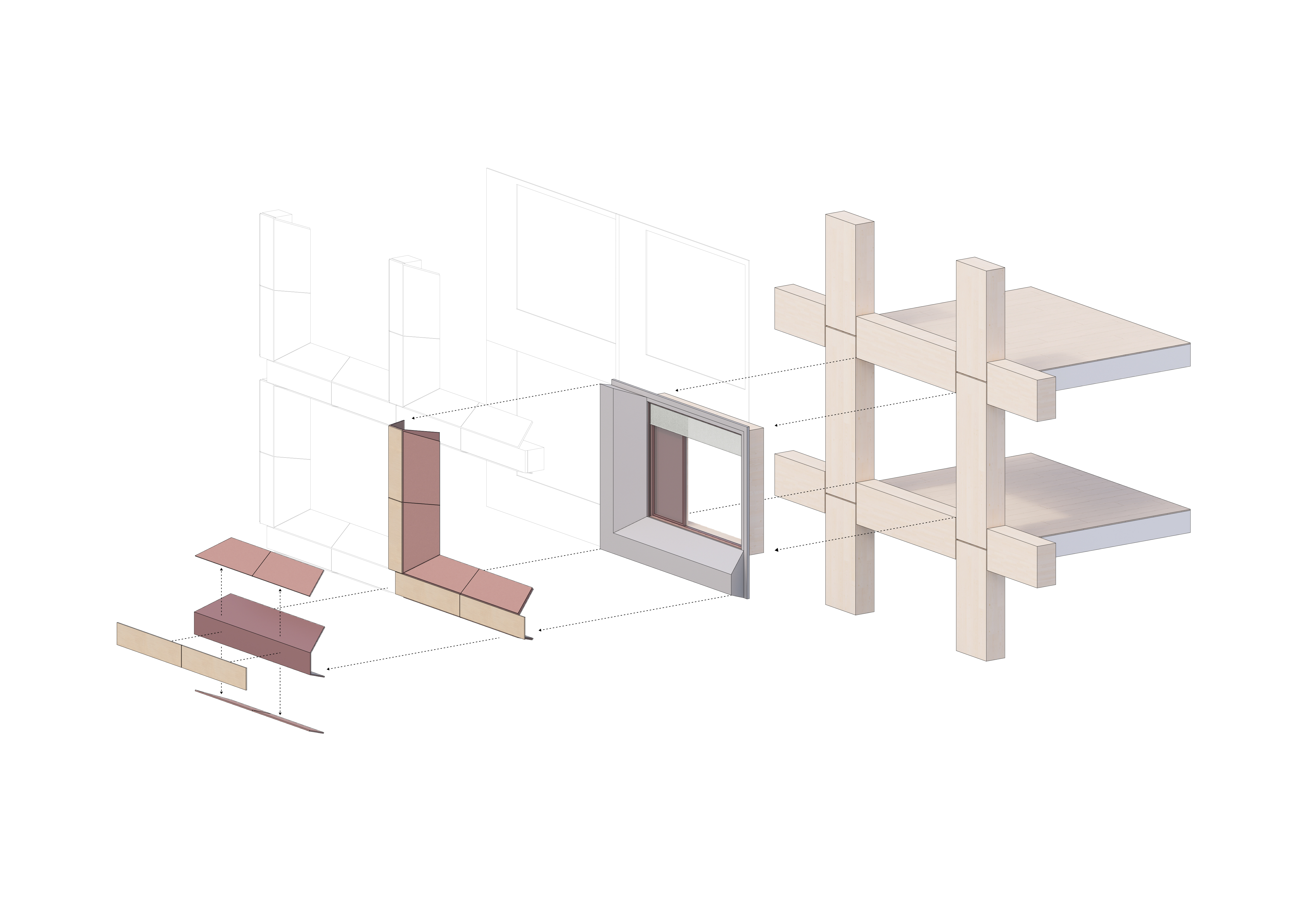The Danish design studio Schmidt Hammer Lassen Architects (SHL) designs the world's tallest residential building with a load-bearing structure in wood.
Written by Klaus Hybler
The 100-metres-tall tower, Rocket&Tigerli, will rise above the ridges in the Swiss city Winterthur, close to Zürich.
The project features a mix of condos, cooperative housing, student housing, a hotel as well retail spaces. The masterplan shows a composition of four structures - each building has its own visual identity - creating a diverse urban space within and around the plot, with a green plaza at the heart of the development. The tower is designed to create a framework for an active and attractive neighborhood. With reference to 19th-century industrial architecture, the project aspires to reconcile the legacy of the historic industrial site and modern living. The façade will be covered in dark red and yellow terracotta bricks combined with details in dusty green.

By using the four buildings to frame the landscape, an urban space is composed by sequences.
SHL has been designing wooden houses for many years, but smaller houses where wood has been chosen for its aesthetic and tactile properties. But now wood is chosen in terms of buildability and production, says Kristian Ahlmark, the Design Director, and Partner of Schmidt Hammer Lassen Architects, who has announced he will be a speaker at the A@W Copenhagen event 7.-8. September 2022.
SHL will be manning up
Ahlmark added, they will be manning up at the schematic design phase which will kick off in September, where 12 to 14 architects will be working. And when the construction starts next year, he expects about five architects will be working directly with the project. The tower is designed for different sizes of apartments from 60 to 140 square metres, making homes for couples and for small and large families. The residential part is split from the hotel with an interstitial floor with amenities like club houses and coworking spaces.

Construction model of the four buildings.
Flexibility is a key issue for the building of the apartments, so during the period, which has started up now and span over the next four to five years, there will still be a certain amount of possibility to chance the different setup of the units inside. The design team has created a mix of apartments, including duplex and split levels, and also considered the special qualities required for housing units in a high-rise building. All apartments have daylight from two sides, provided by a split core, and this is quite unusual for a high-rise building. All the apartments have a balcony and from Floor 8 upwards, where the wind will be stronger, the balconies are designed like an atrium yard inside the core. The floors are primarily made of timber with a top layer of concrete, which is cast at the site. This will bind together the two constructed tubes in the main structure, explained Ahlmark.

SHL is focusing on the integration of daylight and spaciousness.
Wood replaces concrete
The project marks a milestone in the construction of timber buildings – not only because the construction rises 100 meters above the ground, which set the record for residential buildings with a load-bearing timber construction, but also because it introduces an innovative construction system that uses wood as a natural replacement for concrete.
The Swiss company and developer Implenia have worked with the Swiss Federal Institute of Technology of Zürich, ETH, and the engineer company WaltGalmarini AG in developing the new system, which allows the construction of taller timber buildings. The system has replaced the concrete core with wood, which is lighter and stronger. The construction is a tube-in-tube system. The first tube is the façade and a part of the load carrying system – a structural grid with columns of beams 40x90 cm, where the joints are tightened together with a steel rod. And inside the tube you will find a tube similar to the one in the core.
“The methodology is well known, but using structural plywood, which makes the strength of the beams incredible high, and integrating the space frame and the tube-in-tube system is a new concept,” said Ahlmark.

The façade will be covered in dark red and yellow terracotta bricks.
Reducing CO2 emissions
The costs of building a wooden construction are higher but using wood instead of concrete reduces CO2 emissions; in Rocket&Tigerli’s project 30 to 50 percent less emissions in comparison to cast concrete. Then you can add the fact that each of the joints and the façade can be disassambled, which means the whole building can be taken apart and used somewhere else.

The façade construction.
The Design Director of SHL is talking about a moon landing within timber construction.
“We are not able to go as high as 300 or 800 metre like more conventional constructions, but who is to say what is going to happen in the future with using wood or combinations of wood, steel, and concrete. It’s not a battle between materials but using the right material in the right place and using them in a clever way,” he said.
Kristian Ahlmark is pretty sure load-bearing timber constructions, which lower CO2 emissions, will grow in numbers in dense urban areas in relation to buildings using bricks or concrete.
Rocket&Tigerli's construction will start in 2023 and is expected to be completed and ready for residents to move in to by 2026.
© Visualisations by Schmidt Hammer Lassen Architects and Aesthetica.Studio”
(Fact sheet)
Rocket&Tigerli
Winterthur/Switzerland
Size/ 34.500 m2 (excl. sublevels)
Competition/ 1st place international competition
Status/ Ongoing
Client/ Implenia/Ina Invest AG
In Association/ Cometti Truffer Hodel Architects
Landscape Architect/ Schmidt Hammer Lassen Architects / Vogt
Engineer/ B3 / Henaur-Gugler / Waldhauser+Hermann / Bruckner+Ernst
Sustainability/ Targeting SNBS Platinum and 2000-Watt Society
Find out more on the seminar of Kristian Ahlmark at ARCHITECT@WORK Copenhagen.